📣 For more lifestyle news, click here to join our WhatsApp Channel and also follow us on Instagram
Divyanka Tripathi and Vivek Dahiya try dehydrated, preservative-free food: ‘Yeh toh powder hai’
"Yeh abhi 1-2 ghante pehle khaana banaya hai," said Divyanka Tripathi
 Divyanka and Vivek try dehydrated food (Photo: Divyanka Tripathi/Instagram)
Divyanka and Vivek try dehydrated food (Photo: Divyanka Tripathi/Instagram)Actor Divyanka Tripathi recently introduced her husband, Vivek Dahiya, to dehydrated, preservative-free, home-cooked food while packing their bags for a trip. “Dehydrated, preservative-free, home-cooked food ready to eat in a few minutes. Yeh toh powder hai,” exclaimed Vivek on his YouTube vlog.
“Isme bas garam paani daalna hai. Yeh abhi, 1-2 ghante pehle khaana banaya hai, dehydrate karke, pack kiya hai (The foods (dehydrated and packed) have just been prepared. We just need to add hot water to it),” said Divyanka, showing packets of pav bhaji, kadhi rice mixes.
Are dehydrated foods healthy?
Consultant dietitian Garima Goyal said this reflects a conscious shift towards cleaner, more functional eating — a trend that aligns well with modern wellness-oriented diets.
“Dehydration removes moisture from food, which not only aids preservation and shelf-life but also concentrates nutrients and prevents spoilage; when done well, the process retains most vitamins, minerals and antioxidants. For someone focused on health, convenience and minimal processing, choosing these foods can be a smart move,” said Goyal.
From a dietitian’s lens, the benefits of preservative-free dehydrated foods are multiple, she said.
According to Goyal, such foods reduce reliance on artificial additives and stabilisers often present in heavily processed snacks. “They offer convenience without compromising too heavily on nutrient quality, making them useful for busy schedules or travel,” said Goyal.
 Here’s what you should know about fresh vs dehydrated foods (Photo: Freepik)
Here’s what you should know about fresh vs dehydrated foods (Photo: Freepik)
However, there are some caveats, said Goyal, adding that dehydrated items are more calorie-dense by weight because the water is removed, so portion awareness becomes important.
“Also, some nutrients, especially those sensitive to heat or light like vitamin C or certain B-vitamins, may degrade during processing, so they are complementary rather than full replacements for fresh produce,” said Goyal.
The key is to view these dehydrated, preservative-free foods as part of a broader diet. “They serve well alongside fresh vegetables, whole grains, and quality protein,” mentioned Goyal.
Choosing them doesn’t replace the need for diversity, hydration and seasonality in eating. “For best outcomes, check ingredient lists to ensure no hidden sugars or stabilisers, store them properly to avoid moisture regain, and balance them with fresh or minimally processed meals throughout the day,” added Goyal.
DISCLAIMER: This article is based on information from the public domain and/or the experts we spoke to. Always consult your health practitioner before starting any routine.
📣 For more lifestyle news, click here to join our WhatsApp Channel and also follow us on Instagram





- 01
- 02
- 03
- 04
- 05






















